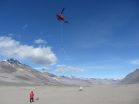(Press-News.org) What happens when lithium-ion batteries overheat and explode has been tracked inside and out for the first time by a UCL-led team using sophisticated 3D imaging.
Understanding how Li-ion batteries fail and potentially cause a dangerous chain reaction of events is important for improving their design to make them safer to use and transport, say the scientists behind the study.
Hundreds of millions of these rechargeable batteries are manufactured and transported each year as they are integral to modern living, powering mobile phones, laptops, cars and planes. Although battery failure is rare, earlier this year, three airlines announced they will no longer carry bulk shipments of lithium-ion batteries in their cargo planes after the US Federal Aviation Administration tests found overheating batteries could cause major fires.
The study by UCL, ESRF The European Synchrotron, Imperial College London and the National Physical Laboratory, published in Nature Communications today, shows for the first time how internal structural damage to batteries evolves in real-time, and provides an indication of how this can spread to neighbouring batteries.
First author, UCL PhD student Donal Finegan (UCL Chemical Engineering), said: "We combined high energy synchrotron X-rays and thermal imaging to map changes to the internal structure and external temperature of two types of Li-ion batteries as we exposed them to extreme levels of heat. We needed exceptionally high speed imaging to capture 'thermal runaway' - where the battery overheats and can ignite. This was achieved at the ESRF beamline ID15A where 3D images can be captured in fractions of a second thanks to the very high photon flux and high speed imaging detector."
Previously, X-ray computed tomography (CT) had only been used to analyse battery failure mechanisms post-mortem with static images and to monitor changes to batteries under normal operating conditions.
The team looked at the effects of gas pockets forming, venting and increasing temperatures on the layers inside two distinct commercial Li-ion batteries as they exposed the battery shells to temperatures in excess of 250 degrees C.
The battery with an internal support remained largely intact up until the initiation of thermal runaway, at which point the copper material inside the cell melted indicating temperatures up to ~1000 degrees C. This heat spread from the inside to the outside of the battery causing thermal runaway.
In contrast, the battery without an internal support exploded causing the entire cap of the battery to detach and its contents to eject. Prior to thermal runaway, the tightly packed core collapsed, increasing the risk of severe internal short circuits and damage to neighbouring objects.
Corresponding author, Dr Paul Shearing (UCL Chemical Engineering), said: "Although we only studied two commercial batteries, our results show how useful our method is in tracking battery damage in 3D and in real-time. The destruction we saw is very unlikely to happen under normal conditions as we pushed the batteries a long way to make them fail by exposing them to conditions well outside the recommended safe operating window. This was crucial for us to better understand how battery failure initiates and spreads. Hopefully from using our method, the design of safety features of batteries can be evaluated and improved."
The team now plan to study what happens with a larger sample size of batteries and in particular, they will investigate what changes at a microscopic level cause widespread battery failure.
INFORMATION:
This study was funded by the Royal Academy of Engineering, Engineering and Physical Sciences Research Council (EPSRC) and National Physical Laboratory. The 'beam time' to conduct these experiments was provided by the ESRF.
A video of the authors explaining the findings of the study can be viewed here: https://www.youtube.com/watch?v=uN8HcqAtDSY&feature=youtu.be
HANOVER, N.H. - Using an airborne imaging system for the first time in Antarctica, scientists have discovered a vast network of unfrozen salty groundwater that may support previously unknown microbial life deep under the coldest, driest desert on our planet. The findings shed new light on ancient climate change on Earth and provide strong evidence that a similar briny aquifer could support microscopic life on Mars.
The study appears in the journal Nature Communications. It is available through open access. A PDF of the study, photos and video also are available on request. ...
PITTSBURGH, April 28, 2015 - African-Americans and Africans who swapped their typical diets for just two weeks similarly exchanged their respective risks of colon cancer as reflected by alterations of their gut bacteria, according to an international study led by researchers at the University of Pittsburgh School of Medicine published online today in Nature Communications.
Principal investigator Stephen O'Keefe, M.D., professor of medicine, Division of Gastroenterology, Hepatology and Nutrition, Pitt School of Medicine, observed while practicing in South Africa that his ...
KNOXVILLE--Many view Antarctica as a frozen wasteland. Turns out there are hidden interconnected lakes underneath its dry valleys that could sustain life and shed light on ancient climate change.
Jill Mikucki, a University of Tennessee, Knoxville, microbiology assistant professor, was part of a team that detected extensive salty groundwater networks in Antarctica using a novel airborne electromagnetic mapping sensor system called SkyTEM.
The research, funded by the National Science Foundation, provides compelling evidence that the underground lakes and brine-saturated ...
Putnam Valley, NY. (April 28, 2015) - Five studies from the current special issue of Cell Transplantation 24(4) devoted to work presented at the 21st meeting of the American Society for Neural Therapy and Repair (ASNTR) in 2014, a society for scientists focused on understanding the causes of, and developing cell and gene therapy and biopharmaceuticals for neurological injury and disease, are currently freely available on-line at: http://www.ingentaconnect.com/content/cog/ct/2015/00000024/00000004.
MSCs promote improvement in patient with complete spinal cord injury
Complete ...
Creating small high schools improves outcomes for students in the overall school district - both in new small schools and existing larger schools - according to a study of New York City schools by researchers at New York University, Syracuse University, and Arizona State University.
The findings, published in the April issue of Educational Researcher, help to answer questions of whether introducing small high schools comes at an expense to the rest of the school district.
"Our findings suggest that there was real, meaningful improvement in New York City's high school ...
CHICAGO, ILL. - When Harlan Dorbin passed away from a rare infection one month after his successful lung transplant surgery, his surgeon turned to Dorbin's sister and made a promise.
"I told her I would get to the bottom of this," said Ankit Bharat, MD, a thoracic surgeon and surgical director of the Northwestern Medicine® lung transplant program. "It was a perfect operation yet this infection caused an abnormal buildup of ammonia that a person's body can't sustain. It's rare but it's almost always fatal. No one knew the cause or how to prevent it. This simply wasn't ...
Despite growing public awareness of sexual assault of women during their military service and increased efforts by the Department of Defense to deter sexual crimes and encourage reporting and help-seeking, a Veterans Affairs study suggests most female service members who experience sexual assault are still unlikely to seek post-assault health care, at least in the short term.
The study, published in Medical Care in April 2015, found that fewer than a third of sexually assaulted servicewomen sought such care.
The low numbers are notable, say researchers, because women ...
How soon after the Big Bang could water have existed? Not right away, because water molecules contain oxygen and oxygen had to be formed in the first stars. Then that oxygen had to disperse and unite with hydrogen in significant amounts. New theoretical work finds that despite these complications, water vapor could have been just as abundant in pockets of space a billion years after the Big Bang as it is today.
"We looked at the chemistry within young molecular clouds containing a thousand times less oxygen than our Sun. To our surprise, we found we can get as much water ...
LOS ANGELES (April 28, 2015) - An international team of scientists led by a Cedars-Sinai researcher has identified a new genetic mutation that appears to protect people from developing Type 2 diabetes.
The finding could lead to the development of new drug therapies to treat about 26 million Type 2 diabetics in the United States who rely on insulin and oral medication to manage the life-threatening disease for which there is no cure.
"We have a wonderful opportunity to personalize the treatment and prevention of this chronic disease," said Mark O. Goodarzi, MD, PhD, ...
Global carbon emissions from forests could have been underestimated because calculations have not fully accounted for the dead wood from logging.
Living trees take in carbon dioxide whereas dead and decaying ones release it. Understanding the proportion of both is important for determining whether a large area of forest is a source of carbon dioxide, or a 'sink' that helps to absorb carbon dioxide from the atmosphere.
Forestry, agriculture and land-use changes account for nearly 25 per cent of global greenhouse gas emissions, second only to the energy sector. New research ...




